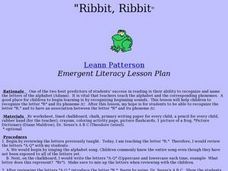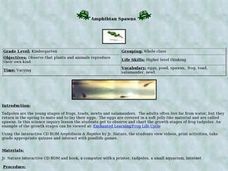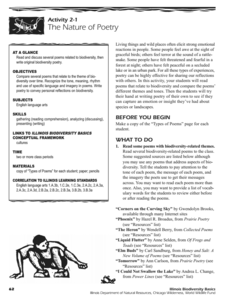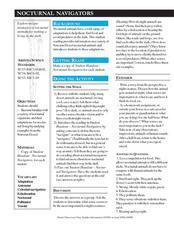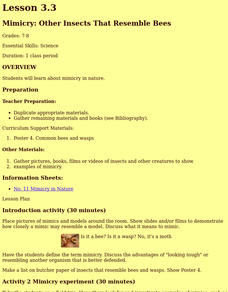Curated OER
From Polliwog to Frog
Students examine how frogs change. In this life cycle lesson, students create a model to show how a frog changes throughout its life. Students will show the process of frog metamorphosis, from polliwog to adult frog.
Curated OER
Frogs, Fabulous Frogs
Students have the opportunity to both interpret and replicate the different shapes and textures observed in the life cycle of a frog. When students apply the watercolor wash to the crayon texture rubbings the designs take on a...
Curated OER
Animal Classifications
While short, this resource could be used as an overview of amphibians. The presentation lists the characteristics of amphibians and provides several examples. For use in a classroom, a teacher could add information.
Curated OER
Ribbit! Ribbit!
Students research a frog's life cycle and habitat using books, the Internet and lecture. Students make origami frogs, write letters to Toad from Arnold Lobel's "Frog and Toad" and participate in a simulated camouflage activity.
Curated OER
Holy Habitats or Meet Metamorphosis
Students examine the metamorphosis of frogs and how it adapts to its environment. They research how world pollutants are effecting the amphibian population.
National Science Teachers Association
Hop into Action
Young scientists find out what makes amphibians such unique and interesting animals in this simple life science lesson plan. After looking at pictures and discussing the characteristics of amphibians, learners complete a series of three...
Curated OER
Learning Activities: Magic Words
Students use poetry to compare and contrast humans and frogs.
Omaha Zoo
Monitoring Amphibians
What sort of shoes do frogs wear? Open toad sandals. If your scholars want experience collecting field samples, this is the lesson for you. After learning the proper way to collect field samples, pupils catch amphibians to test for...
Curated OER
Biodiversity in Illinois-Pond Habitats
Second graders construct a pond habitat in the classroom using a small swimming pool partially filled with water, real cattails, a tree log adjoining, and plastic animal life appropriate to a pond setting. They examine the frog in detail...
Curated OER
Marshland Wonders
Students review the characteristics of wetlands and list their benefits. After viewing short videos, they identify the organims that make their home in wetlands and how they have adapted. They compare and contrast the characteristics...
Kids Can Have Fun
Cut and Paste Alligator
Who knew an alligator could have so many different looks? For this activity, youngsters choose a set of eyes out of eight choices and cut and paste them onto an alligator. They color their creatures after the eyes have been attached.
Curated OER
Reptile and Amphibian Word Search
In this reptile and amphibian instructional activity, students complete a word search puzzle by finding 24 terms associated with the different types of reptiles and amphibians.
Curated OER
Sunken Millions
This PowerPoint features a game based on the animal life. The interactive slides include 20 questions about animal needs, animal groups, and animal traits. The questions include multiple choice answers and 4 different levels of...
Curated OER
Amphibian Spawns
Students observe tadpoles as they gradually change into adults. For this amphibian biology lesson, students watch tadpoles in a tank in the classroom, keep a daily record of what they observe, and chart the growth development of the...
Illinois Department of Natural Resources
Section Two: Why is Biodiversity Important?
Explore soil, genetic traits, natural resources, and pollution in a series of lessons that focus on biodiversity. Kids complete experiments to learn more about the importance of varied genes and organisms in an ecosystem.
Curated OER
Classification and Adaptations- Streams, Rivers, and Lakes - Where the Land Meets the Sea And Caribbean Reef
In this science worksheet set, students answer 14 short answer questions about the classification and adaptation of life in streams, rivers, and lakes. They also answer 15 questions about life "Where the Land Meets the Sea" and in a...
Curated OER
Mapping Where Animals Live
What type of reptiles live in New York State? This instructional activity gets the class thinking about what factors determine where particular animals live. They analyze the Hudson Valley environment, identify specific reptile and...
Curated OER
Learning Activities: What Color Am I?
Young scholars identify various species of anurans by their skin coloration. They describe how coloration contributes to survival.
Curated OER
How Does Your Garden Grow?
Students read The Garden by Arnold Lobel, plant seeds to discover what makes them grow, and record their observations in their journals.
Curated OER
Simple Keys and Nutrition
Third graders identify descriptive questions as a method for distinguishing objects and for identifying labels for objects and categorizing objects. They participate in a student grouping activity, then using pictures of different types...
Desert Discoveries
Nocturnal Navigators
Young biologists take a look at some of the unique ways that nocturnal animals survive in the dark. After reading a terrific student handout which is embedded in the plan, learners work together to answer questions about what they have...
Curated OER
Mimicry: Other Insects That Resemble Bees
Learners design a conceptual experiment to test whether mimics actually benefit from the fact they resemble other organisms or objects. They define the term mimicry. They focus on insects that resemble bees and wasps.
Curated OER
Animal Myth Busters
In these reading comprehension worksheets, students read about animal myths and animal facts. Students answer 5 reading comprehension questions about the text.
Curated OER
Amphibians Crossword Puzzle
For this biology worksheet, students complete a crossword puzzle with 24 questions about different types of amphibians and functions of their body parts.





